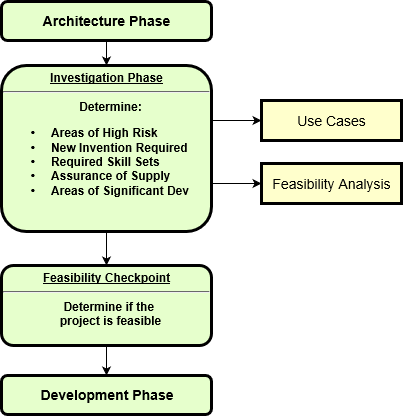The purpose of the investigation phase is to determine if a project is viable from technical, logistical, and business viewpoints. As an electrical engineer one needs to determine aspects of the project that may not be feasible. In order to do that one must understand the application use cases.

Use Cases
- What purposes will the device be used for?
- What are the different modes of operation of the device?
- What are the different functions of the device and what are the step-by-step processes users go through to use each function?
- What environmental conditions will the device be subjected to? Temperature? Air Flow? Humidity? Dust? Stationary? Quiet or Noisy?
- What will be the electromagnetic environment? Industrial or consumer? Grounding? Isolation? Metal Chassis (Faraday Cage)? Shielded cables? Fiber-Optics?
- What is a rough outline of the manufacturing process? Are special modes needed or special test functions?
- What is the field repair and replacement strategy? What are the spare parts?
- How long do we intend to sell this device and how long do we support it after obsolescence?
Once use cases are better understood, an EE needs to think about aspects of the project that may not be feasible.
Feasibility Concerns
- Areas of high risk
- Areas where new invention is required
- Lacking required skill sets to develop the product
- Areas approaching the boundaries of maximum specifications, e.g. excessive heating, data transmissions rates
- Assurance of supply – components of the device must be available for the expected sales life plus the support time after obsolescence.
- Areas requiring significant development
Each feasibility concern needs to be addressed. Create experiments and build partial prototypes to investigate areas of concern. Ensure that there is a viable path forward for each feasibility concern.
Next: Development Phase
